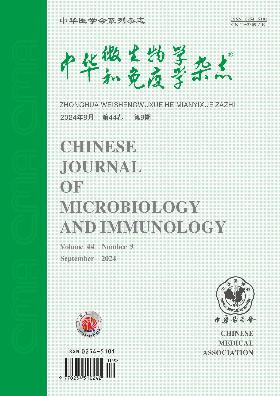引起儿童猩红热和心绞痛的化脓性链球菌的分子流行病学特征
Q4 Immunology and Microbiology
引用次数: 0
摘要
目的了解化脓性链球菌的耐药性、大环内酯类耐药基因、毒力基因及emm类型。方法收集2018年1 - 12月复旦大学附属儿童医院临床诊断为猩红热的儿科门诊患者(2-11岁)247份口咽拭子标本。及时将标本送微生物实验室进行分离鉴定,化脓性链球菌培养后分离出菌株,进行杆菌肽药敏试验鉴定。并用游标卡尺测定了抑菌带的直径。采用KB法测定其对红霉素、克拉霉素、克林霉素、氨苄西林、头孢曲松、诺氟沙星、氯霉素等7种抗生素的敏感性。PCR检测大环内酯耐药基因(mefA、ermA、ermB和Tn916转座子)和毒力基因(speA、speB、speC、speG、speH、speI、speJ和speK)。按照美国疾病预防控制中心网站的方案进行emm基因扩增和测序。结果247份标本共分离到86株化脓性链球菌。对红霉素、克拉霉素和克林霉素的耐药率分别为89.5%、95.3%和96.5%。对氨苄西林(100.0%)、头孢曲松(100.0%)、诺氟沙星(90.7%)和氯霉素(95.3%)均有较高的敏感性。mefA、ermA、ermB和Tn916基因阳性率分别为20.9%、24.4%、98.8%和97.7%。猩红热和心绞痛患者的mefa携带率有显著差异。speA、speB、speC、speG、speH、speI、speJ、speK、speL和speM毒力基因阳性率分别为8.1%、100.0%、95.3%、100.0%、80.2%、90.7%、10.5%、100.0%、5.8%和5.8%。共鉴定出7种emm类型,主要类型为emm12.0(75.6%)、emm12.19(9.3%)和emm1.0(8.1%)。emm1.0型菌株的抑菌带直径小于emm12.0型菌株。不同emm类型菌株的毒力基因谱不同。所有菌株均携带speB、speG和speK基因。emm1.0型菌株携带speA毒力基因,而emm12.0型菌株多携带speB、speC、speG、speH、speI和speK毒力基因。结论emm类型与毒力基因谱和杆菌肽抑制带直径有关。建议在杆菌肽抑制药敏试验中,除单纯观察抑菌带的形成外,还应测量抑菌带的直径。关键词:化脓性链球菌;抗菌素耐药性;毒力基因;电解加工类型;杆菌肽药敏试验本文章由计算机程序翻译,如有差异,请以英文原文为准。
Molecular epidemiological characteristics of Streptococcus pyogenes causing scarlet fever and angina in children
Objective
To investigate the antimicrobial resistance, macrolide-resistance genes, virulence genes and emm types in Streptococcus pyogenes isolates.
Methods
A total of 247 oropharyngeal swab specimens were collected from pediatric outpatients (aged 2-11 years) who were clinically diagnosed as scarlet fever in Children′s Hospital of Fudan University from January to December, 2018. These specimens were timely sent to the Microbiology Laboratory for isolation and identification of Streptococcus pyogenes strains were isolate after culturing and identified with bacitracin susceptibility test. Moreover, the diameter of bacitracin inhibition zone was measured by vernier caliper. Their susceptibility to seven antibiotics, including erythromycin, clarithromycin, clindamycin, ampicillin, ceftriaxone, norfloxacin and chloramphenicol, were measured using KB method. Macrolide-resistance genes (mefA, ermA, ermB and Tn916 transposon) and virulence genes (speA, speB, speC, speG, speH, speI, speJ and speK) were detected by PCR. Amplification and sequencing of emm gene were conducted according to the protocol in the website of Centre for Disease Control and Prevention (CDC).
Results
A total of 86 strains of Streptococcus pyogenes were isolated from the 247 specimens. Their resistance rates to erythromycin, clarithromycin and clindamycin were 89.5%, 95.3% and 96.5%, respectively. However, these isolates showed high susceptibility to ampicillin (100.0%), ceftriaxone (100.0%), norfloxacin (90.7%) and chloramphenicol (95.3%). The positive rates of mefA, ermA, ermB and Tn916 genes were 20.9%, 24.4%, 98.8% and 97.7%. There was significant difference in the mefA-carrying rates between patients with scarlet fever and angina. The positive rates of virulence genes of speA, speB, speC, speG, speH, speI, speJ, speK, speL and speM were 8.1%, 100.0%, 95.3%, 100.0%, 80.2%, 90.7%, 10.5%, 100.0%, 5.8% and 5.8%. Seven emm types were identified and the predominant types were emm12.0 (75.6%), emm12.19 (9.3%) and emm1.0 (8.1%). The diameter of bacitracin inhibition zone was smaller in isolates of emm1.0 type than in emm12.0 type strains. The profile of virulence genes varied in the strains of different emm types. All types of strains carried speB, speG and speK genes. The isolates of emm1.0 type carried speA virulence gene, while speB, speC, speG, speH, speI and speK genes were more often identified in emm12.0 type isolates.
Conclusions
This study showed that emm types were associated with the profile of virulence genes and the diameter of bacitracin inhibition zone. It was recommended that the diameter of bacitracin inhibition zone should be measured in bacitracin inhibition susceptibility test apart from only observing the formation of inhibition zone.
Key words:
Streptococcus pyogenes; Antimicrobial resistance; Virulence gene; emm type; Bacitracin susceptibility test
求助全文
通过发布文献求助,成功后即可免费获取论文全文。
去求助
来源期刊

中华微生物学和免疫学杂志
Immunology and Microbiology-Virology
CiteScore
0.50
自引率
0.00%
发文量
6906
期刊介绍:
Chinese Journal of Microbiology and Immunology established in 1981. It is one of the series of journal sponsored by Chinese Medical Association. The aim of this journal is to spread and exchange the scientific achievements and practical experience in order to promote the development of medical microbiology and immunology. Its main contents comprise academic thesis, brief reports, reviews, summaries, news of meetings, book reviews and trends of home and abroad in this field. The distinguishing feature of the journal is to give the priority to the reports on the research of basic theory, and take account of the reports on clinical and practical skills.
 求助内容:
求助内容: 应助结果提醒方式:
应助结果提醒方式:


